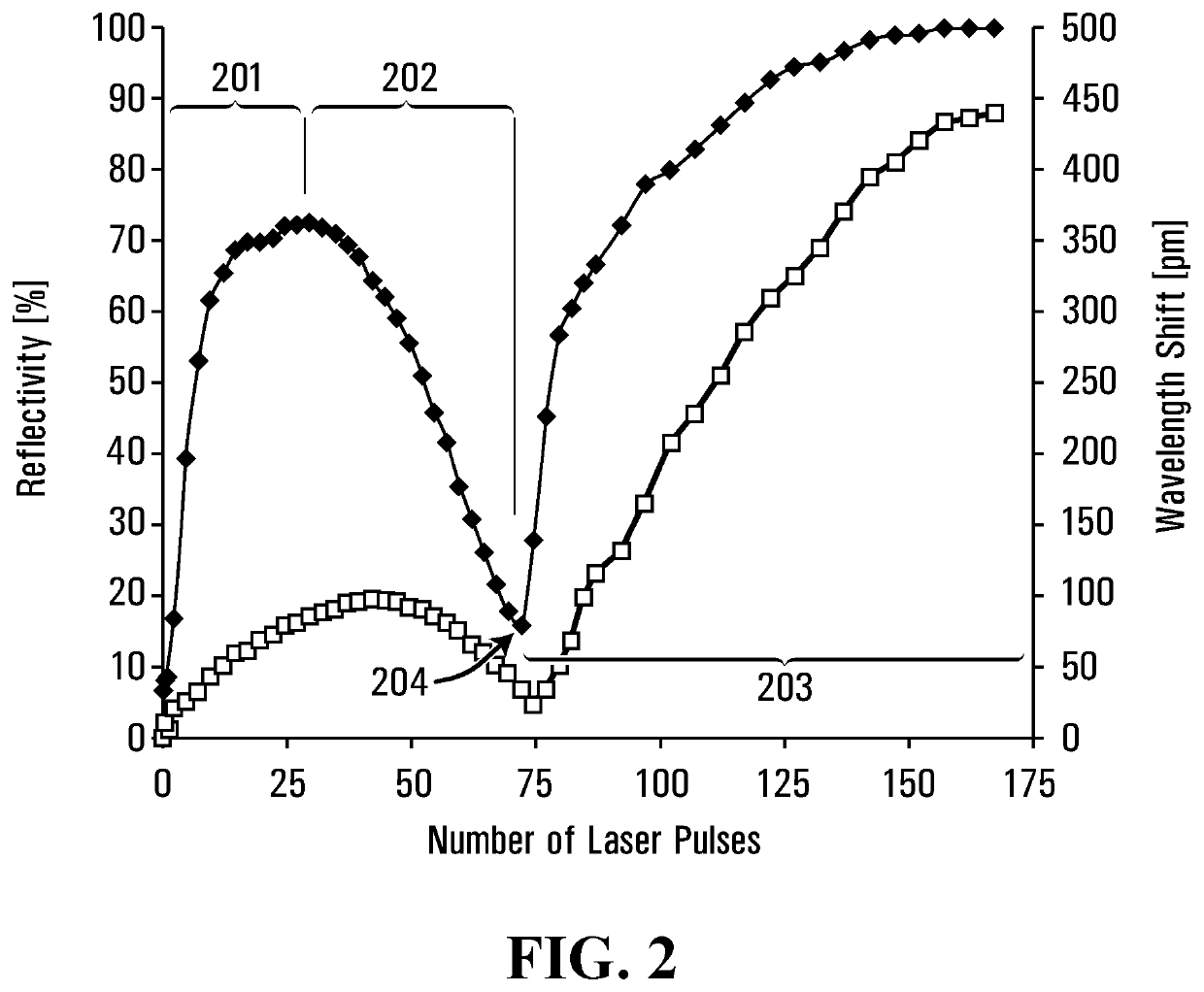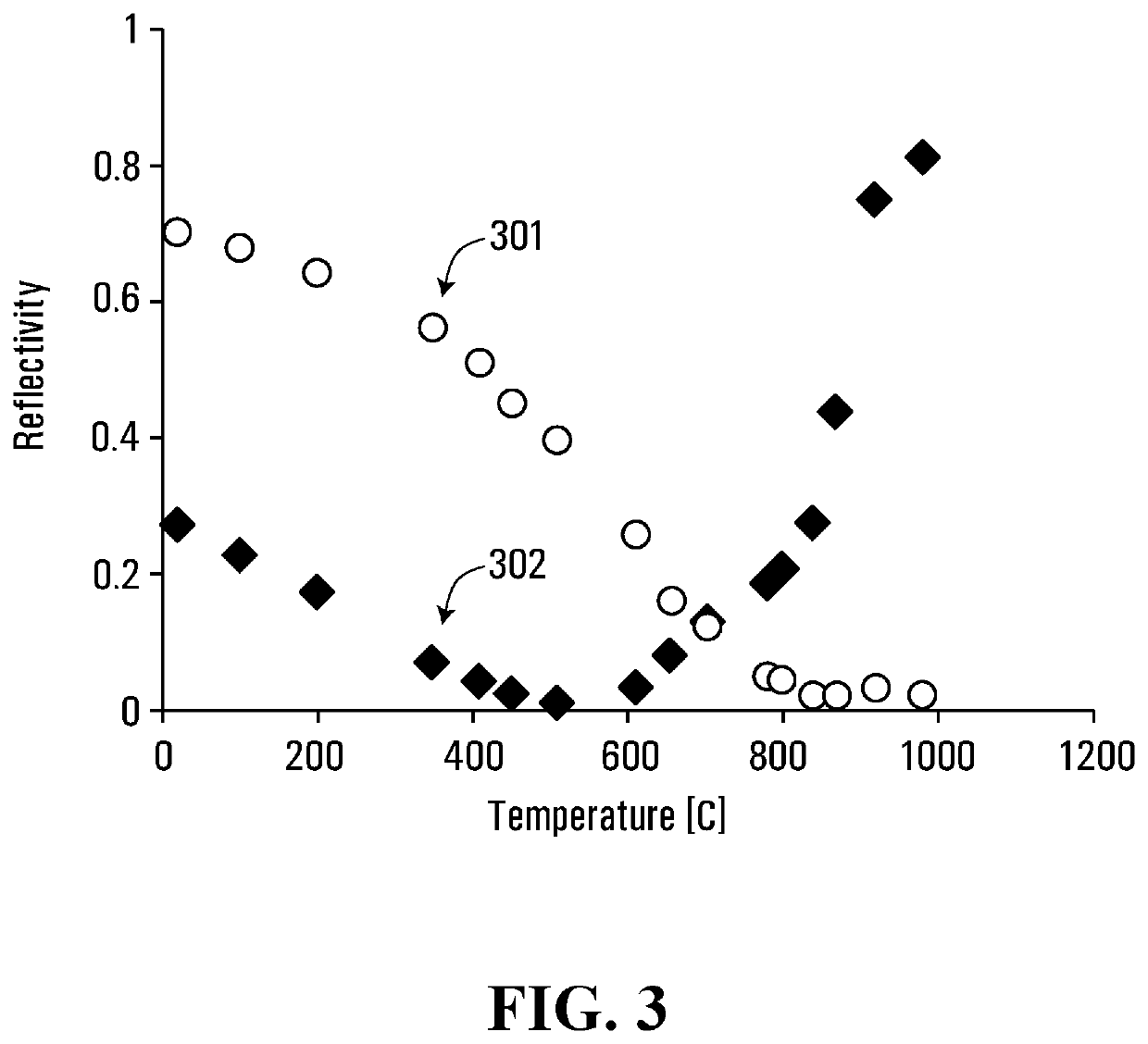Low insertion loss high temperature stable fiber Bragg grating sensor and method for producing same
a fiber bragg grating, low insertion loss technology, applied in the direction of heat measurement, force measurement by measuring optical property variation, instruments, etc., can solve the problems of bragg gratings, affecting the quality of bragg gratings, and causing localized damage at the core-cladding interfa
- Summary
- Abstract
- Description
- Claims
- Application Information
AI Technical Summary
Problems solved by technology
Method used
Image
Examples
example 1
Formation of Type II Bragg Grating with Low Insertion Loss
[0066]A regeneratively amplified Ti:sapphire femtosecond laser system with 80 fs pulse duration and operated at 800 nm wavelength was used as a laser source. The laser was operated at 5 Hz and 1 mJ laser pulse energy and the pulse chirped to 500 fs. The beam was focused through a 19 mm cylindrical lens and a phase mask with 1.065 μm pitch into the core of a standard Ge-doped core silica telecom fiber (Corning SMF-28; ˜4% Ge doping level core in a pure silica fiber substrate). The fiber was placed on a jig at 1 mm distance behind the phase mask ensuring pure two beam interference and a 532.5 nm grating pitch within the fiber. This periodicity in the fiber produced a fundamental Bragg resonance within the fiber. The laser beam was swept vertically across the fiber core at ˜3 μm / s by dithering the focusing lens. During the exposure, the evolution of the grating reflectivity was continuously monitored in both transmission and ref...
example 2
Thermal Treatment
[0068]To test the effect of thermal treatment, two gratings were inscribed, side by side, on the same strand of fiber. First, a grating was written using the conditions detailed in Example 1, terminating the exposure when the grating was in the stage 202 of the grating structure evolution (i.e. irradiation terminated prior to Bragg resonance wavelength erasure). This grating is identified as (302) in FIG. 3. A second grating was written using grating inscription parameters needed to produce a Type I grating (laser pulse intensities below Ith). The second grating, whose annealing behavior is known, served as a reference to the annealing behavior of the first grating. The fiber was then inserted in the furnace and the temperature incremented by roughly 100° C. every hour. As shown in FIG. 3, the Type I grating (301) annealed as expected, losing half of its reflectivity around 500° C. and decreasing below the 2% reflectivity at 1000° C. The B grating (302) however, aft...
example 3
Fabrication of Grating Array with Irradiation Beyond Bragg Resonance Erasure
[0070]Applying the method described in Mihailov, S. J., Grobnic, D., Smelser, C. W., Lu, P., Walker, R. B. and Ding, H., “Bragg grating inscription in various optical fibers with femtosecond infrared lasers and a phase mask,” Opt. Mater. Express 1(4), 754-765 (2011), arrays were fabricated with up to 24 Type-II fs-IR FBGs, using phase masks having uniform periods between 1.043 μm and 1.097 μm. The gratings were written through a 19 mm focal-length cylindrical lens, using 800 nm, 350 fs, 0.85 mJ regeneratively amplified pulses, at a repetition rate of 3 Hz. The fiber surface was placed 200 μm from the phase mask and the beam was swept ±10 μm over its cross section with a frequency of 0.2 Hz. As a result of the phase mask to fiber proximity, the written grating periods are the same as the corresponding phase masks, resulting in second order Bragg resonances. The strip and recoat method was employed, and except...
PUM
| Property | Measurement | Unit |
|---|---|---|
| wavelength | aaaaa | aaaaa |
| temperatures | aaaaa | aaaaa |
| wavelength range | aaaaa | aaaaa |
Abstract
Description
Claims
Application Information
 Login to View More
Login to View More - R&D
- Intellectual Property
- Life Sciences
- Materials
- Tech Scout
- Unparalleled Data Quality
- Higher Quality Content
- 60% Fewer Hallucinations
Browse by: Latest US Patents, China's latest patents, Technical Efficacy Thesaurus, Application Domain, Technology Topic, Popular Technical Reports.
© 2025 PatSnap. All rights reserved.Legal|Privacy policy|Modern Slavery Act Transparency Statement|Sitemap|About US| Contact US: help@patsnap.com



